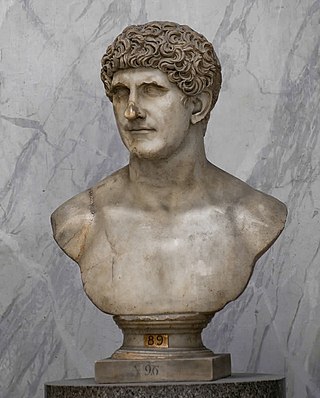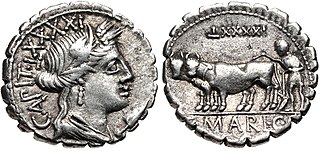Related Research Articles

The gens Petronia was a plebeian family at ancient Rome. This gens claimed an ancient lineage, as a Petronius Sabinus is mentioned in the time of Lucius Tarquinius Superbus, the last of the Roman kings, but few Petronii are mentioned in the time of the Republic. They are frequently encountered under the Empire, holding numerous consulships, and eventually obtaining the Empire itself during the brief reign of Petronius Maximus in AD 455.

The gens Julia was one of the most prominent patrician families in ancient Rome. Members of the gens attained the highest dignities of the state in the earliest times of the Republic. The first of the family to obtain the consulship was Gaius Julius Iulus in 489 BC. The gens is perhaps best known, however, for Gaius Julius Caesar, the dictator and grand uncle of the emperor Augustus, through whom the name was passed to the so-called Julio-Claudian dynasty of the first century AD. The nomen Julius became very common in imperial times, as the descendants of persons enrolled as citizens under the early emperors began to make their mark in history.

Achaia, sometimes spelled Achaea, was a province of the Roman Empire, consisting of the Peloponnese, Attica, Boeotia, Euboea, the Cyclades and parts of Phthiotis, Aetolia-Acarnania and Phocis. In the north, it bordered on the provinces of Epirus vetus and Macedonia. The region was annexed by the Roman Republic in 146 BC following the sack of Corinth by the Roman general Lucius Mummius, who was awarded the surname "Achaicus". Initially part of the Roman province of Macedonia, it was made into a separate province by Augustus.

Pannonia Inferior, lit. Lower Pannonia, was a province of the Roman Empire. Its capital was Sirmium. It was one of the border provinces on the Danube. It was formed in the year 103 AD by Emperor Trajan who divided the former province of Pannonia into two parts: Pannonia Superior and Pannonia Inferior. The province included parts of present-day states of Hungary, Serbia, Croatia, and Bosnia and Herzegovina. The province was bordered to the east by a Sarmatian tribe—the Iazyges. Later, the Vandals appeared to the north-east.
The gens Calvisia was an ancient Roman family, which first rose to prominence during the final decades of the Republic, and became influential in imperial times. The first of the gens to obtain the consulship was Gaius Calvisius Sabinus in 39 BC.

The gens Vibia was a plebeian family at ancient Rome. Although individuals named Vibius appear in history during the time of the Second Punic War, no members of this gens are found at Rome until the final century of the Republic. The first of the Vibii to obtain the consulship was Gaius Vibius Pansa in 43 BC, and from then until imperial times the Vibii regularly filled the highest offices of the Roman state. The emperors Trebonianus Gallus and Volusianus each claimed descent from the family.

The gens Antonia was a Roman family of great antiquity, with both patrician and plebeian branches. The first of the gens to achieve prominence was Titus Antonius Merenda, one of the second group of Decemviri called, in 450 BC, to help draft what became the Law of the Twelve Tables. The most prominent member of the gens was Marcus Antonius.
The gens Caecinia was a plebeian family of Etruscan origin at ancient Rome. Members of this gens are first mentioned in the time of Cicero, and they remained prominent through the first century of the Empire, before fading into obscurity in the time of the Flavian emperors. A family of this name rose to prominence once more at the beginning of the fifth century.

The gens Maria was a plebeian family of Rome. Its most celebrated member was Gaius Marius, one of the greatest generals of antiquity, and seven times consul.
The gens Septimia was a minor plebeian family at ancient Rome. The gens first appears in history towards the close of the Republic, and they did not achieve much importance until the latter half of the second century, when Lucius Septimius Severus obtained the imperial dignity.
The gens Ostoria, occasionally written Hostoria, was a plebeian family at Rome. Members of this gens are first mentioned in the early years of the Empire. Although only a few of them achieved any prominence in the Roman state, many others are known from inscriptions. The most illustrious of the Ostorii was probably Publius Ostorius Scapula, who was consul during the reign of Claudius, and afterward governor of Britain.
The gens Paccia, occasionally written Pactia, was a minor plebeian family at ancient Rome. Only a few members of this gens achieved distinction in the Roman state, of whom the most illustrious was Gaius Paccius Africanus, consul in AD 67.
The gens Statia was a minor plebeian family at ancient Rome. Members of this gens are first mentioned in the early decades of the Republic, but the name does not appear again in history until the time of Cicero. The Statii remained relatively undistinguished until the reign of Trajan, when Lucius Statius Aquila was raised to the consulship.
References
- ↑ Ségolène Demougin, Prosopographie des chevaliers romains julio-claudiens (43 av. J.-C. - 70 ap. J.-C.), (Rome: École Française de Rome, 1992) pp. 404f
- ↑ Demougin, Prosopographie des chevaliers, p. 549; CIL XI, 6940
- ↑ Demougin, Prosopographie des chevaliers, pp. 581f; Tacitus, Historiae iii.5; iv.70
- ↑ Peter Weiß, "Zwei vollständige Konstitutionen für die Truppen in Noricum (8. Sept. 79) und Pannonia inferior (27. Sept. 154)", Zeitschrift für Papyrologie und Epigraphik , 146 (2004), pp. 239–254
- ↑ Demougin, Prosopographie des chevaliers, p. 543; Tacitus, Historiae i.17
- ↑ CIL III, 11759; AE 1937, 61
- ↑ CIL III, 5179; CIL IX, 4753
- ↑ CIL III, 5163
- ↑ CIL III, 14362; CIL III, 5776
- ↑ CIL III, 5177; CIL XVI, 75
- ↑ CIL III, 5174, CIL III, 5181
- ↑ CIL III, 5182
- ↑ CIL III, 5170
- ↑ RMD-02, 93 = AE 1988, 915; CIL III, 5167, CIL III, 5175
- ↑ CIL III, 5165
- ↑ CIL III, 5173
- ↑ RGZM 32
- ↑ CIL III, 5164, CIL III, 5172
- ↑ CIL III, 5161; CIL III, 5169
- ↑ CIL III, 5166, CIL III, 11826
- ↑ CIL III, 5171; see also CIL VI, 1599, CIL IX, 2438, Cassius Dio, 71.5
- ↑ CIL III, 11543
- ↑ CIL X, 3849
- ↑ CIL IX, 4964
- 1 2 3 4 5 Paul M. M. Leunissen, Konsuln und Konsulare in der Zeit von Commodus bis Severus Alexander (Amsterdam: J.C. Gieben, 1989), pp. 272f
- ↑ IG 3499, 3500
- ↑ CIL III, 3421
- ↑ CIL VIII, 2615
